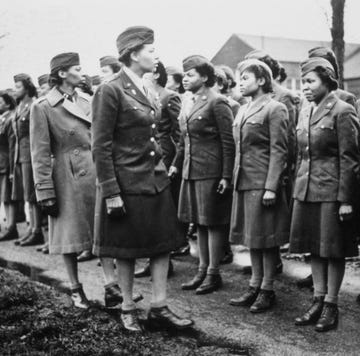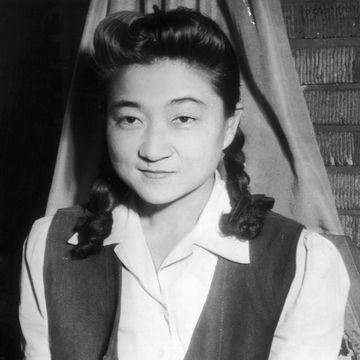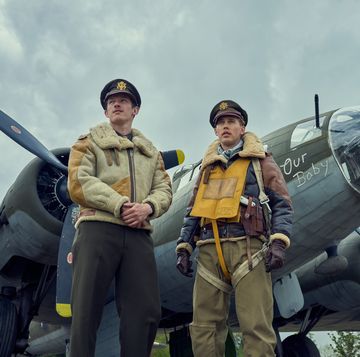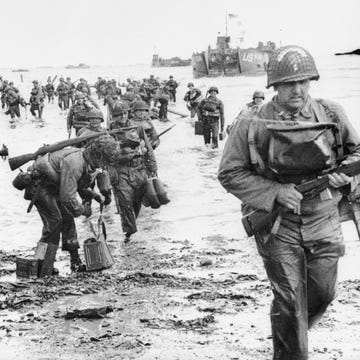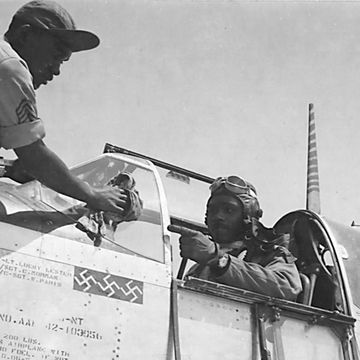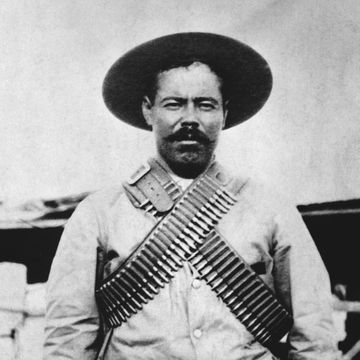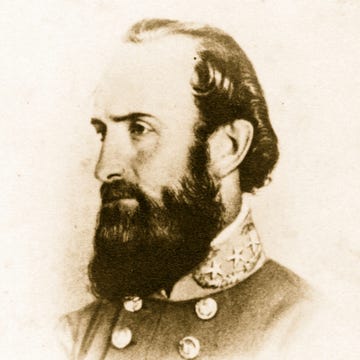Here’s what you’ll learn when you read this story:
- Twins Buck and Bill Pattillo were among the original aviators in the U.S. Air Force’s Thunderbirds.
- The brothers previously served in World War II, and Bill had a near-death experience during an April 1945 mission.
- As Thunderbirds, Buck and Bill heavily involved in crafting the squad’s aerial choreography including one signature move still performed today.
There might just be something about brothers and aviation innovation. Of course, the aerial pairing that first comes to mind for most of us is Orville and Wilbur Wright, whose experiments in Kitty Hawk, North Carolina, gave us the very act of manned flight we now take for granted. But there have been other sky-bound brothers who have earned their place in aviation history, from the Granville Brothers’ Gee Bee Airplanes to Mark and Scott Kelly’s groundbreaking work with NASA.
There’s another set of sibling aviators you might not know by name, but air show fans or anyone who’s watched the new Netflix documentary Air Force Elite: Thunderbirds will almost certainly know the legacy they left behind. If you’ve ever marveled at the “Bomb Burst” grand finale of an air show from the U.S. Air Force’s Thunderbirds, you can thank Buck and Bill Pattillo.
Twin brothers Charles “Buck” Pattillo and Cuthbert “Bill” Pattillo were born on June 3, 1924, in Atlanta. Virtually inseparable, and equally driven toward careers in aviation, both brothers graduated from Atlanta Technical High School in 1942 and enlisted in the U.S. Army Air Forces that November.
The brothers completed the aviation cadet program, earning their wings and commission as second lieutenants in March of 1944. Serving in the European Theater of Operations during World War II, the brothers flew with the 352nd Fighter Group. The 352nd gained the nickname the “Blue-Nosed Bastards of Bodney” for the distinct blue paint sported on the noses of the P-51 Mustangs that the division flew (The 352nd had previously flown Republic P-47 Thunderbolts, switching to the Mustang roughly a month after the Pattillo brothers joined the ranks).
The twins’ time in the 352nd would mark a period of separation for the brothers, though not through any choice of their own. On April 16, 1945, during an attack on Ganacker airfield, a Luftwaffe airfield that also served as a subcamp of the Flossenbürg concentration camp, Bill’s P-51 was shot down by anti-aircraft fire. Bill was able to bail out of his plane in time, but he was captured by German forces and held as a POW for the remainder of the war.
Bill and his P-51, the Sweet and Lovely, had flown 135 combat missions before his capture. Buck, for his part, earned the Distinguished Flying Cross and the Air Medal with two oak leaf clusters for his service. After the war, the brothers left active duty, but they returned in 1948—Buck in February of that year and Bill in March—by which point the U.S. Air Force had become its own branch of the military.
In January 1949, the Pattillo brothers were assigned to the 22nd Fighter Squadron, 36th Tactical Fighter Wing, at Fürstenfeldbruck Air Base in Germany. While there, they helped to form the U.S. Air Forces in Europe aerial demonstration team, a precursor to the Thunderbirds known as the Skyblazers. Flying both F-80 and F-84 planes, the brothers were a foundational force in this early aerial demonstration team. Per his official Air Force biography, Buck served as left wing and alternative lead “in more than 250 air shows throughout Western Europe, North Africa, Greece and Turkey” and was awarded the Legion of Merit for his work with the Skyblazers.
After returning stateside, Buck and Bill eventually found themselves as gunnery instructors at Luke Air Force Base in Arizona. It was there, in 1953, that the siblings were called upon to use their Skyblazers experience to help form the U.S. Air Force Air Demonstration Squad, colloquially known as the Thunderbirds. That this lineup of aerial acrobats included a set of twin brothers, both highly decorated for their service in World War II, would have been fodder enough for a positive PR campaign for the nascent demonstration squad.
But the Pattillo twins, one of whom flew left wing while the other flew right, were also heavily involved in crafting the squad’s aerial choreography. One major move attributed to the twins is the “Bomb Burst,” an aerial stunt wherein the planes separate in such a manner that their contrails form a burst, like a firework or the namesake explosive.
The Pattillo twins graced the covers of magazines and newspapers, compelling readers with reports of their aerial daring, stories of their wartime escapades, and the striking image of their identical flight suits framing their nearly identical faces. Their public personas, paired with their precision in the cockpit, served as a powerful public relations tool, not just for the Thunderbirds, but also for the comparatively new branch of the Air Force as a whole. The Pattillos and the Thunderbirds represented as a show of positive, patriotic military strength in the post-war period that helped pave the way for America’s dominant strategy in fighting the looming Cold War that would consume the collective consciousness for the next several decades.
After their time with the Thunderbirds, both brothers continued their distinguished military careers. Bill flew combat missions during the Vietnam War and concluded his military career in 1980, retiring with the rank of major general. Buck retired one year later, having attained the rank of lieutenant general. Two decades after their retirement, the brothers were inducted into the Georgia Aviation Hall of Fame.
Ultimately, the Pattillo brothers were the last surviving members of the original Thunderbirds squad. Bill died in 2014 at the age of 89; Buck lived another five years until passing away at age 94. Neither brother received the traditional inurnment at Arlington National Cemetery, however, until 2022; it had been requested that this final honor wouldn’t take place until both brothers and their respective spouses had all passed on so that they could all be laid to rest together.
In a final send-off to the Pattillo twins, the current incarnation of the Thunderbirds took to the skies to pay tribute to two of their own. Per Task & Purpose:
“As the team of six F-16 fighter jets flew over the cemetery, the left and right wing pilots, Maj. Ian Lee and Maj. Lauren Schlichting, pulled up in the team’s first-ever dual ‘missing man’ formation, a maneuver they dubbed the ‘Pattillo Pull.’”
Michale Natale is a News Editor for the Hearst Enthusiast Group. As a writer and researcher, he has produced written and audio-visual content for more than fifteen years, spanning historical periods from the dawn of early man to the Golden Age of Hollywood. His stories for the Enthusiast Group have involved coordinating with organizations like the National Parks Service and the Secret Service, and travelling to notable historical sites and archaeological digs, from excavations of America’ earliest colonies to the former homes of Edgar Allan Poe.






